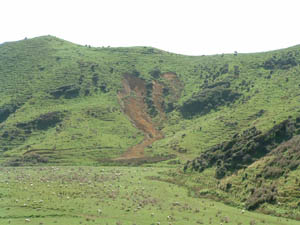Soil health

The long-term economic viability of any farm depends on the maintenance of soil quality. Environmental and economic performance and sustainability of our agriculture, including forestry, can be greatly influenced by soil quality.
The effects of intensive farming on soil and water quality, and surrounding environment are sometimes causing concern about the long-term viability of our natural resources.
The physical condition of a soil has an important influence on farm economics and environment. It affects processes such as soil erosion and land drainage. Soil physical condition is commonly referred to as ‘soil structure’. Soil structure determines the porosity, strength and stability of a soil.
A well-structured soil has many stable aggregates with a wide range of sizes. It contains a large number of pores both within and between those aggregates, which maintain the correct balance of air and water in the soil and also allows easy emergence of seedlings and growth of plant roots.
Poorly structured soil either does not have aggregates of many different sizes or the aggregates are packed tightly together with few pores. Poor structure in a light textured soil results in unstable aggregates and the soil appears fine and powdery. Poor soil structure can markedly increase the risk of wind erosion.
The Waikato region has a wide range of soils, which include some of the most productive soils in New Zealand. However, even high quality soils can be degraded through some land use practices. Only about 34 per cent of monitored sites fully meet national targets, with compaction and excessive fertility being the main soil quality issues in the intensively farmed areas of the Waikato region.
Soil scientists have documented that a poorly aerated or compacted soil can potentially be reducing 200 kg dry matter per ha per month in pasture production. Once the soil is properly aerated, at correct depth and time, you can increase about 30 per cent dry matter within six months and about 50 per cent of dry matter production after 8 months. The basic issue we need to remember is - soil health is farmers’ wealth.
Visual soil assessment (VSA)
Visual soil assessment (VSA) was developed by well known soil scientist Graham Shepherd.
The VSA Field Guide has been produced to help land managers assess soil quality easily, quickly, reliably and cheaply on a paddock scale. Assessing and monitoring soil quality with VSA, and following guidelines for prevention or recovery of soil degradation, can help develop and implement sustainable land management practices.
How VSA is undertaken
VSA is based on the visual assessment of key soil ‘state’ and plant ‘performance’ indicators of soil quality, presented on a scorecard.
Soil quality is ranked by assessment of the soil indicators alone. It does not require knowledge of paddock history.
Plant indicators, however, require knowledge of immediate crop and paddock history. Because of this, only those who have this information will be able to complete the plant indicator scorecard satisfactorily.
Visual scoring (VS)
Each indicator is given a visual score of 0 (poor), 1 (moderate), or 2 (good), based on the soil quality observed when comparing the paddock sample with three photographs in the field guide manual. The score given to each indicator is multiplied by the weighting factor to give a VS ranking. The total of the VS rankings gives the overall ranking score for the sample you are assessing. You compare this with the score ranges at the bottom of the page to determine whether your soil has good, moderate or poor soil quality.
A copy of the revised (second) edition of the guide can be purchased from the author, Graham Shepherd - gshepherd@BioAgriNomics.com, or from Waikato Regional Council. For further details and for a demonstration of the VSA package, please contact Waikato Regional Council on 0800 800 401.
Soil management
Managing peat
The Waikato region contains about half of New Zealand’s peatland. Most of this land has been developed.
While drainage has greatly improved our ability to farm land profitably, too much drainage can speed up shrinkage of peat soils. A balance between drainage and cultivation is needed in order to protect our peat soils for future generations. Find out more.
Cultivation
Cultivation provides us with food crops and new pastures. But it also reduces the organic matter in soil, and can lead to increased erosion. Waikato Regional Council recommends growing annual cover crops, reducing cultivation and adding organic matter (compost, manure) to soil to help restore soil organic matter. Find out more.
Pugging and compaction
Pugging and compaction leave soils less productive. High stock densities combined with prolonged rainfall leave Waikato region soils vulnerable to pugging and compaction. This can be minimised by careful stock and land management.
Find out more about how pugging and compaction damage soils, and which soils are more susceptible. Learn how land use and climate makes the Waikato region especially vulnerable to pugging and compaction.
Rules and compliance
Know the rules - Read Waikato Regional Council's rules for erosion control structures, soil disturbance and cleanfill activities.
Permitted activity guides - The permitted activity guides provide a summary overview of a number of our rules for farming activities.
Earthworks, soil disturbance and erosion


